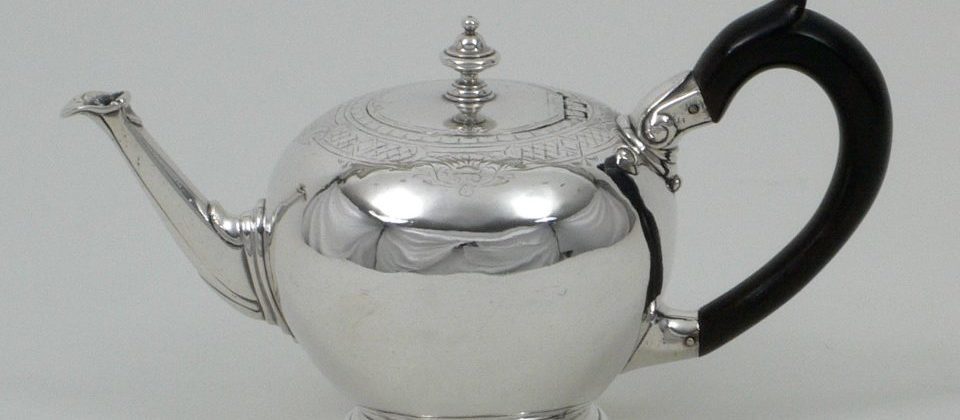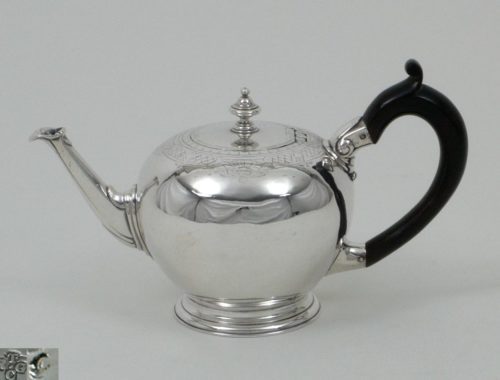Object Number: #903
London 1727/8
Maker: Thomas Cooke II, Richard Gurney
City hallmark: crowned leopard’s head for London (Jackson 1921: 85)
Maker’s mark: Monograms „RG/TC“in a curved shild for Richard Gurney and Thomas Cooke II (Grimwade 1990 nr. 2324)
Assay mark: Lion passant (Jackson 1921: 85)
Dimensions: Height: 10,5 cm (3,94 in.); weight: 450 g.
Detailed Information
Fine George II Silver, Round Teapot
The silver teapot is standing on a round, profiled standing ring. Its shoulders are adorned with engraved geometrical and naturalistic ornaments. The flat lid is embedded into the corpus with a hinge and is decorated with a cast, baluster finial. The almost straight spout is short and has strongly profiled rims. The ear-shaped, wooden handle is applied on edged and round bridges.
The type of round teapot in English silver appears after the pear-shaped teapots and is influenced from the so-called boccaro or buccaro earthenware from China. The name “boccaro” comes from Spanish and Portuguese and was used for the imported earthenware from Mexico, Chile and Peru. The name applied also to the Chinese, red and brown Yixing earthenware (later Ming-period) imported from China. The present teapot features a fine, discretely decorated example of this style.
Maker
Richard Gurney was son of George Gurney of Turrington. He apprenticed since 1717 to Richard Bayley on payment of 10 pounds. He became a master maker in 1724. He entered a mark as largeworker, in partnership with Thomas Cooke II in 1727. He had several other entered marks after 1734 (s. Grimwade 1990: 530).
Thomas Cooke II was son of John Cooke from Warwick. He apprenticed since 1719 to Richard Bayley on payment of 25 guineas. He became master maker on 1726. His second mark since 1727 is one as partner with Richard Gurney. He had several marks entered afterwards. Cooke died in 1761 (s. Grimwade 1990: 470).
Literature
Grimwade, Ar., London Goldsmiths 1697-1837. Their marks and lives from the original registers at Goldsmiths’ Hall and other sources, GB: Faber and Faber, 1990
Hernmarck, Carl, Die Kunst der europäischen Gold- und Silberschmiede von 1450 bis 1830, C.H. Beck Verlag: München, 1978
Jackson, Ch., J., English Goldsmiths and their marks, London: MacMillan and Co. Limited, 1921



